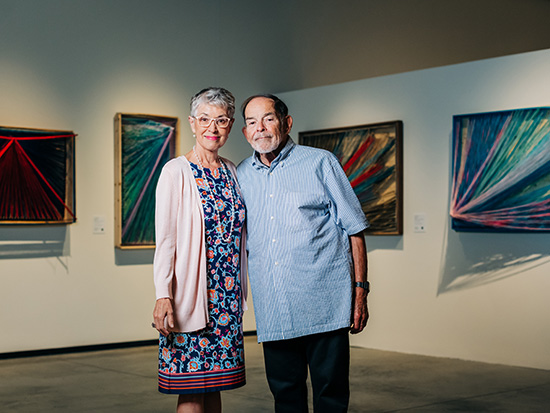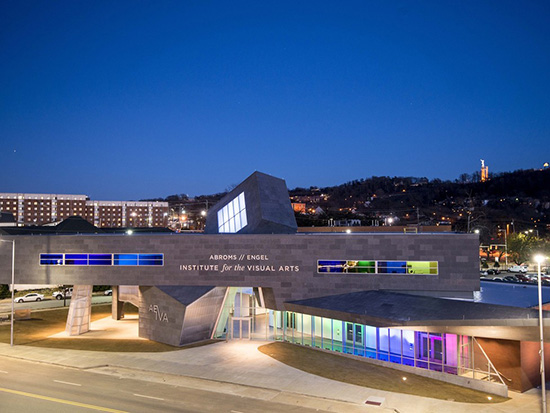 Lydia Cheney and Jim Sokol at UAB's AEIVA.
Lydia Cheney and Jim Sokol at UAB's AEIVA.
Photography by Andrea MabryThe future of contemporary visual art at the University of Alabama at Birmingham has been safeguarded by a first-of-its-kind gift for the university, from art patrons Lydia Cheney and Jim Sokol.
The pair are longtime supporters of UAB, and by creating the endowed directorship for UAB’s Abroms-Engel Institute for the Visual Arts, they are ensuring a secure position for AEIVA’s director. It is the first non-faculty staff position to be endowed at UAB, and a gift that Cheney and Sokol hope will reap benefits for decades to come.
AEIVA opened in January 2014 and will celebrate its first 10 years in January 2024. John Fields, who has been with AEIVA since the beginning, is the first Lydia Cheney and Jim Sokol Endowed Director of AEIVA. Fields first met the pair years ago, working as interim director of the Department of Art and Art History’s Visual Arts Gallery. Executive Director of UAB Arts Alliance Lili D. Anderson has worked with Cheney and Sokol for many years, starting while at the Birmingham Museum of Art, and it was through Anderson that they committed to the AEIVA endowment.
“Part of our hope and goal is to ensure that AEIVA becomes the premier venue for contemporary art in Birmingham, Alabama and the Southeast,” Cheney said. “That is the big picture, and the efforts we make with endowing a director will serve that purpose. It is joined with the fact that we both are crazy about John, but it is bigger than that. We will still have that sense of having contributed to the well-being of AEIVA for a long time.”
Collectors of contemporary and outsider art, Cheney and Sokol have filled their home with works by artists including Odili Donald Odita, Jeff Koons, Willie Cole, Enrique Martínez Celaya, Frank Fleming, Chris Clark, Mose T, Leslie Wayne, Titus Kaphar, Amy Pleasant, Radcliffe Bailey, June Wayne and many more. Cheney and Sokol each have their own style, and the layout of their home allows them to showcase their favorite artists and personal influences. Their collection also includes works by UAB art faculty John Dillon, Sonja Rieger, Gary Chapman and Edith Frohock, and graduates Celestia Morgan, Kristin Skees and Joel Seah.
Their roots in art in Birmingham are deep and go back decades, as are their connections to UAB. The couple met in 1991 and realized they both had an interest in art. Their very first date was at the Birmingham Museum of Art. They traveled with the BMA Collectors Circle for Contemporary Art for years and were involved with and learning from curators and collectors.
“It was a golden age for contemporary art in Birmingham,” Cheney said. “We did not realize it at the time, but we do now.”
David Moos was the first BMA curator of Modern and Contemporary Art and helped the museum acquire some of its most important works. Cheney says he was very influential in advising people in Birmingham in establishing their collections, offering his time and expertise. During that same period, Sokol looked to UAB to educate himself about art.
“I decided to audit some art history courses at UAB because at some point I said, ‘We’re buying this stuff and it would help if I knew something about it.’ I had a dangerously small amount of knowledge about art,” Sokol said. He took every class that Katherine McIver taught at UAB in Italian Renaissance — and attended exhibits at the UAB Visual Arts Gallery, now the ArtLab, which is where he met John Fields.
Cheney began working at UAB in 1991, in what is now the Integrative Center for Aging Research, followed by what is now the O’Neal Comprehensive Cancer Center at UAB in 1997. Her connections led the couple to assist with ArtBlink Gala, the Cancer Center’s biggest fundraising event, for which they helped find artists, Sokol says, including Karen Graffeo, Lonnie Holley, Darius Hill and Amy Pleasant.
Sokol and Cheney are also supporters of the UAB Marnix E. Heersink School of Medicine, notably through the James D. Sokol and Lydia C. Cheney Endowed Medical Scholarship, established in 2007, in support of medical education. Additionally, Cheney established an endowment to support UAB’s Education Abroad program, which supports travel for undergraduate students while continuing their education. They have been part of the UAB family for decades, and UAB is grateful for their vision and generosity, says Vice President for Advancement and Strategic Initiatives Tom Brannan.
“This gift is evidence of Jim Sokol and Lydia Cheney’s commitment to both UAB and contemporary art,” Brannan said. “The endowed directorship has had, and will continue to have, a transformative effect on UAB and the surrounding community.”
 The couple credits former School of Arts and Humanities Dean Bert Brouwer for cultivating the relationships with Hal and Judy Abroms and Marvin and Ruth Engel, who helped make the institute a reality. When the concept for the UAB art institute began to take shape, Sokol and Cheney were on board. Their connections in the contemporary art world have inspired some of AEIVA’s landmark exhibitions, which have often included pieces from their personal collection.
The couple credits former School of Arts and Humanities Dean Bert Brouwer for cultivating the relationships with Hal and Judy Abroms and Marvin and Ruth Engel, who helped make the institute a reality. When the concept for the UAB art institute began to take shape, Sokol and Cheney were on board. Their connections in the contemporary art world have inspired some of AEIVA’s landmark exhibitions, which have often included pieces from their personal collection.
In late 2013, after inviting artist Titus Kaphar to tour campus while he stayed with them, Sokol brought him to see the installation of AEIVA’s first show. As soon as he saw AEIVA, the artist declared, “I want to have a show here.” This led to the exhibition “Titus Kaphar: Misremembered,” which Fields organized. The next year, Kaphar received a prestigious MacArthur “Genius” Fellowship.
Cheney and Sokol have directly facilitated or contributed works to several other pivotal AEIVA exhibitions, including “Leslie Wayne: Mind the Gap,” “A La Carte: A Visual Exploration of our Relationship with Food,” “Enrique Martínez Celaya: Small Paintings 1974-2015,” “Material Evidence,” “Willie Cole: Transformations,” “Warhol: Fabricated,” “Thornton Dial: I, Too, Am Alabama” and “Marking Time: Art in the Age of Mass Incarceration.”
Visit AEIVA, 1221 10th Ave. South, Birmingham, from noon-5 p.m. Tuesday-Saturday. Admission is free. Visit aeiva.uab.edu or call 205-975-6436. Explore AEIVA’s virtual learning library here.
“With AEIVA, we have had the opportunity to build our culture from the ground up. And so, this first 10 years will sort of inform every future version of AEIVA,” Fields said. “Long after I am gone, long after Lili is gone, the foundation of what we have created will ripple on for the next half century, and we are very proud of that.”